
compass Rose
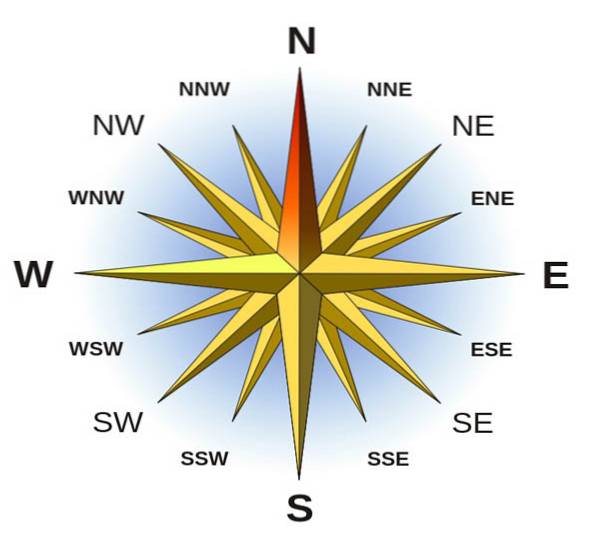
What is the compass rose?
The compass rose is a figure formed by 4 basic rhombuses joined together at their base, with the points directed in divergent directions. Therefore, it forms a cross that, placed parallel to the ground, one of the points points forward, another backwards, the third points to the right and the fourth to the left..
In such a way that the points indicate the four main courses that can be taken on the earth plane. These directions are directed to the four cardinal points of the horizon circle, called North, South, East and West..
The rhombus pointing north usually has a fleur-de-lis at its tip. In turn, the compass rose is subdivided into other intermediate courses between the previous ones, called lateral courses..
For example, we can walk exactly in the direction located just halfway between North and East, which is called Northeast. Also our course could be the Southeast, that is, between the South and the East or there is also the Northwest and the Southwest.
In addition, the compass rose can subdivide the directions, pointing the way between the previous directions. This is how collateral and collateral courses are formed, until completing a compass rose with 32 indicated courses..
Where does the name Rose of the Winds come from?
The main need to orient yourself with precision arose with navigation, since most places on land have landmarks to orient yourself, such as a mountain or a river. However, this is not the case in the ocean and the beginning of long-distance navigation was on sailing boats, so it was necessary to establish the direction of the winds..
The constant and main winds had their own names and the directions were defined from the point from which they blew. Thus, for example, the Greeks called the wind that blew from the North, the Aparctias, which the Hispanics called Tramontano and the Romans Septentrio.
While the Greeks and Romans called the wind from the Northwest (NNO) Thrascias and the Hispanics call it Cierzo. So this multi-pointed figure was designed that resembles the many petals of a rose and is used to indicate the direction of the winds, which is why it is known as the Rose of the Winds..
The compass rose was published for the first time on the world map designed by the Majorcan Jew Abraham Cresques in 1375. In this compass rose, the names of the main 8 Mediterranean winds and the 32 directions are indicated. Although Pliny the Elder had already described it in Book II of his work Natural History in the year 74 AD.
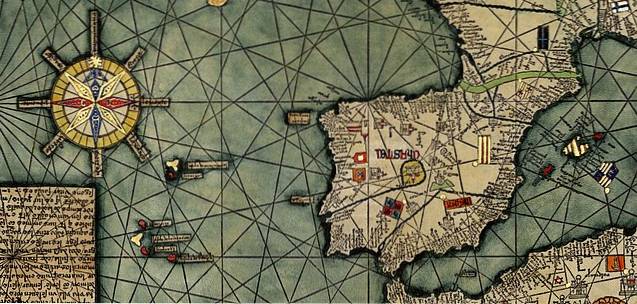
The Cardinal points
The cardinal points are the 4 basic directions that exist in the plane of the circumference of the earth's horizon. So if we stand in the center of a vast meadow and look around us, we will be observing the plane of the horizon. That is, the line that we see where the sky meets the earth and also the horizon can be seen clearly in the middle of the ocean..
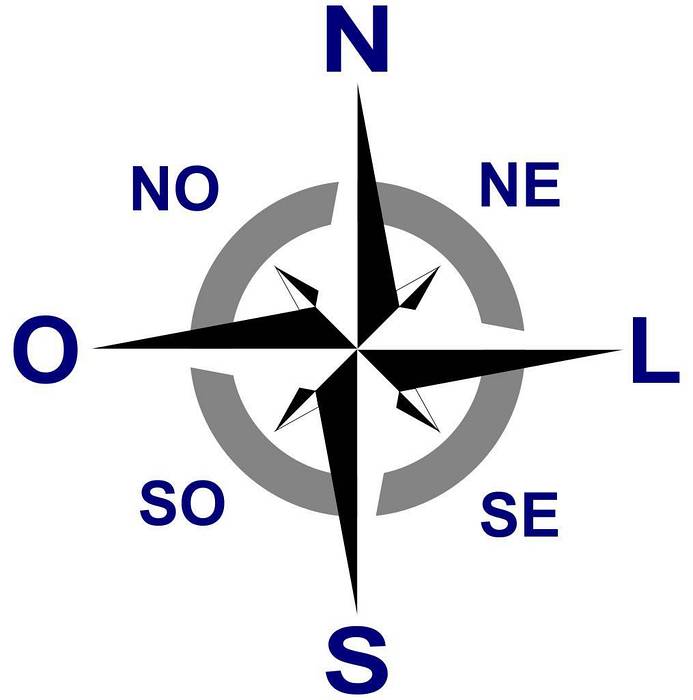
In such a way that there are 4 fundamental directions to which we can go, which are: moving forward, backward, to the right or to the left. These bearings are each directed to an imaginary point on the horizon called the cardinal point..
It is considered that the point that coincides with the magnetic pole of the Earth and therefore attracts the compass needle, is called North. While the point located in the opposite direction is called South. Then, if we are facing North, the point in the direction to the right is named East and the one on the left, West.
Set the orientation of the cardinal points
In order to communicate to another person what direction we are taking, those 4 basic directions must have a reference point. This reference is the magnetic North of the Earth, a point close to the North Pole that generates a magnetism such that it attracts a magnetized needle..
That point called North is the first cardinal point and by facing it, we can define the other 3 cardinal points. Thus, the South is the cardinal point facing our back, the East is located to our right and the West to the left..
If we do not have a compass to define the location of the cardinal points, we can orient ourselves by the Sun. This is because the Sun rises in the East and sets in the West..
It is enough to open the arms in a cross, pointing with the right hand to where the Sun rises and with the left to the place where it is hidden. In this way, the North will be in front, the South at the back, the East on the right and the West on the left..
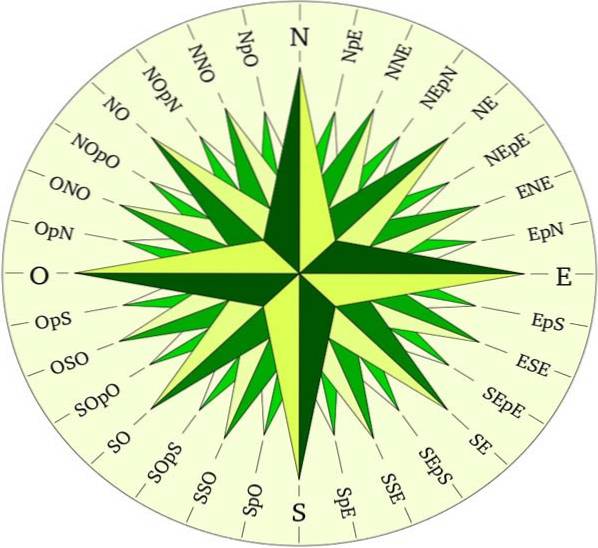
From these 4 cardinal points, the rest of the directions indicated by the compass rose are established until the 32 directions are completed. The position of all these directions can also be determined according to the trajectory of various stars in the sky..
Then, if we divide the circumference that forms the compass rose into the 360 degrees that all circumference has, it is easy to mark any heading.
What is the compass rose for?
The compass rose serves to locate us in space and to set our course, that is, to orient ourselves on the earthly plane. It appears on all cartographic maps to indicate North in relation to the map design..
From this, the compass rose has multiple applications, from navigation to the proper location of a structure on the ground..
The navegation
The initial goal of the compass rose was to help set the course for navigation on the high seas. In fact, the compass rose is also called a nautical rose..
At the beginning, the various directions were established taking as a reference the winds, the trajectory of the Sun and the stars, based on the compass rose. Later, with the invention of the compass and combined with the reference system of the compass rose, it was greatly facilitated to orient oneself.
On the other hand, when the airplane was invented, the compass rose as part of the compass, was the basis for setting air directions. Then, with the development of technology today the compass rose has been replaced by radars, satellites and GPS devices.
Land exploration
In most cases, when traveling on land there are many landmarks to help you find your way around. For example, mountains, types of vegetation, rivers, rocks and others. However, in the great sandy deserts there are not many landmarks to guide you either..
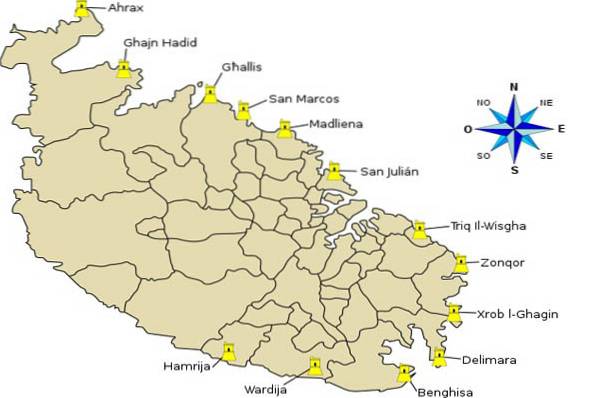
In any case, the use of the compass rose also allows travelers and explorers to set the course..
The orientation of a construction
In architecture, they define the compass rose as a tool that graphically presents the direction, intensity and frequency of the winds..
For example, to build an airport, you must first make a detailed study of the winds in the area, their intensity and direction. For this, the direction and intensity of the winds are established for at least 5 years, in order to establish their frequency..
With this information, a compass rose is constructed, which is a diagram that indicates the average intensity and direction of the winds in each sector of the horizon circle..
On the other hand, the compass rose is useful for planning any construction on the ground. This because it allows defining the predominant direction of the winds and the incidence of the Sun's rays..
Which, in turn, is important to orient the buildings, in such a way as to take advantage of natural lighting. As well as the ability to regulate the temperature of the winds.
Artillery
In the past, the compass rose was also used to establish the correct direction and angle to point guns. In fact, the 6,400 parts in which the sphere of the compass rose can be divided is called "thousandth of artillery".
References
- Casas-Torres, J.M. and Higueras-Arnal, A. (1977). Compendium of General Geography. RIALP editions.
- Maass, S.F. and Valdez-Pérez, M.E. (2003). Basic principles of cartography and automated cartography. Mexico: Autonomous University of the State of Mexico.
- Pastrana-Caicedo, E. and Sánchez-Hernández, D. (2015). Wind and natural ventilation in architecture. Sustainable Environments Laboratory N ° 2.
- Quiroga-Venegas, L. and Acosta-Millán, G. (2013). Geography. High school. ST Editorial. Mexico.
- Raisz, E. and Mantero, J.M. (2005). General cartography. Trad. 7th edition Omega, Barcelona.
- Robinson, A.H., Sale, R.D., Morrison, J.L., Muehrcke, P.C., Ravella-Vives, J.M., Ferrer, R.M. (1987). Mapping elements. Omega 1st Edition.



Yet No Comments